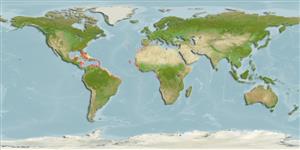Environment: milieu / climate zone / depth range / distribution range
Écologie
marin récifal; profondeur 0 - 5 m (Ref. 3723), usually 0 - 2 m (Ref. 40849). Subtropical; 43°N - 13°S
Western Atlantic: Massachusetts, USA and northern Gulf of Mexico to Brazil, including the Caribbean Sea (Ref. 3723); absent in Bermuda. Eastern Atlantic: Cape Verde and Dakar, Senegal to Luanda, Angola (Ref. 4497).
Length at first maturity / Taille / Poids / Âge
Maturity: Lm 19.3 range ? - ? cm
Max length : 55.0 cm TL mâle / non sexé; (Ref. 2683); common length : 35.0 cm TL mâle / non sexé; (Ref. 3633); poids max. publié: 200.00 g (Ref. 5217)
Rayons mous dorsaux (Total): 13-14; Rayons mous anaux: 12 - 13. No ridge between nostril and eye (Ref. 26938).
An inshore, surface-dwelling species forming sizeable schools (Ref. 3723). Feeds mainly on sea grasses and small fishes (Ref. 3723). Mainly used as bait for offshore game fishes such as sailfishes and marlins; utilized as a food fish in the West Indies (Ref. 3723).
Life cycle and mating behavior
Maturité | Reproduction | Frai | Œufs | Fécondité | Larves
Robins, C.R. and G.C. Ray, 1986. A field guide to Atlantic coast fishes of North America. Houghton Mifflin Company, Boston, U.S.A. 354 p. (Ref. 7251)
Statut dans la liste rouge de l'IUCN (Ref. 130435)
Menace pour l'homme
Reports of ciguatera poisoning (Ref. 30911)
Utilisations par l'homme
Pêcheries: intérêt commercial mineur; appât: usually
Plus d'informations
RéférencesAquacultureProfil d'aquacultureSouchesGénétiqueElectrophoresesHéritabilitéPathologiesTraitementNutrientsMass conversion
Outils
Articles particuliers
Télécharger en XML
Sources Internet
Estimates based on models
Preferred temperature (Ref.
123201): 20.5 - 28.1, mean 27.3 °C (based on 858 cells).
Phylogenetic diversity index (Ref.
82804): PD
50 = 0.5005 [Uniqueness, from 0.5 = low to 2.0 = high].
Bayesian length-weight: a=0.00380 (0.00278 - 0.00520), b=3.08 (3.02 - 3.14), in cm total length, based on LWR estimates for this species (Ref.
93245).
Niveau trophique (Ref.
69278): 2.3 ±0.1 se; based on diet studies.
Generation time: 1.9 ( na - na) years. Estimated as median ln(3)/K based on 2
growth studies.
Résilience (Ref.
120179): Milieu, temps minimum de doublement de population : 1,4 à 4,4 années (K=0.58 questionable; assuming tmax>3).
Prior r = 0.46, 95% CL = 0.28 - 0.77, Based on 1 stock assessment.
Fishing Vulnerability (Ref.
59153): Low to moderate vulnerability (27 of 100).
Climate Vulnerability (Ref.
125649): High to very high vulnerability (75 of 100).
Nutrients (Ref.
124155): Calcium = 62.8 [19.5, 142.1] mg/100g; Iron = 0.681 [0.267, 1.717] mg/100g; Protein = 18.4 [15.6, 20.9] %; Omega3 = 0.136 [0.053, 0.389] g/100g; Selenium = 14.2 [5.6, 39.2] μg/100g; VitaminA = 31.6 [6.7, 165.2] μg/100g; Zinc = 0.985 [0.565, 1.712] mg/100g (wet weight);
